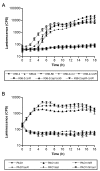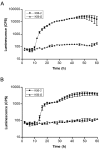Detection of N-acyl homoserine lactones using a traI-luxCDABE-based biosensor as a high-throughput screening tool
- PMID: 18667064
- PMCID: PMC2518144
- DOI: 10.1186/1472-6750-8-59
Detection of N-acyl homoserine lactones using a traI-luxCDABE-based biosensor as a high-throughput screening tool
Abstract
Background: Bacteria use N-acyl homoserine lactone (AHL) molecules to regulate the expression of genes in a density-dependent manner. Several biosensors have been developed and engineered to detect the presence of all types of AHLs.
Results: In this study, we describe the usefulness of a traI-luxCDABE-based biosensor to quickly detect AHLs from previously characterized mutants of Burkholderia cenocepacia and Pseudomonas aeruginosa in both liquid and soft-agar co-culture assays in a high-throughput manner. The technique uses a co-culture system where the strain producing the AHLs is grown simultaneously with the reporter strain. Use of this assay in liquid co-culture allows the measurement of AHL activity in real time over growth. We tested this assay with Burkholderia cenocepacia and Pseudomonas aeruginosa but it should be applicable to a broad range of gram negative species that produce AHLs.
Conclusion: The co-culture assays described enable the detection of AHL production in both P. aeruginosa and B. cenocepacia and should be applicable to AHL analysis in other bacterial species. The high-throughput adaptation of the liquid co-culture assay could facilitate the screening of large libraries for the identification of mutants or compounds that block the synthesis or activity of AHLs.
Figures



Similar articles
-
Identification of N-acylhomoserine lactones in mucopurulent respiratory secretions from cystic fibrosis patients.FEMS Microbiol Lett. 2005 Mar 15;244(2):297-304. doi: 10.1016/j.femsle.2005.01.055. FEMS Microbiol Lett. 2005. PMID: 15766782
-
Electrochemical detection of quorum sensing signaling molecules by dual signal confirmation at microelectrode arrays.Anal Chem. 2011 Mar 15;83(6):2097-103. doi: 10.1021/ac1028243. Epub 2011 Feb 16. Anal Chem. 2011. PMID: 21323339
-
Isolation and characterization of quorum-sensing signalling molecules in Pseudomonas aeruginosa isolates recovered from nosocomial infections.APMIS. 2013 Sep;121(9):886-9. doi: 10.1111/apm.12047. Epub 2013 Jan 18. APMIS. 2013. PMID: 23331337
-
Utilization of acyl-homoserine lactone quorum signals for growth by a soil pseudomonad and Pseudomonas aeruginosa PAO1.Appl Environ Microbiol. 2003 Oct;69(10):5941-9. doi: 10.1128/AEM.69.10.5941-5949.2003. Appl Environ Microbiol. 2003. PMID: 14532048 Free PMC article.
-
Rapid screening of quorum-sensing signal N-acyl homoserine lactones by an in vitro cell-free assay.Appl Environ Microbiol. 2008 Jun;74(12):3667-71. doi: 10.1128/AEM.02869-07. Epub 2008 Apr 18. Appl Environ Microbiol. 2008. PMID: 18424536 Free PMC article.
Cited by
-
Production of cell-cell signalling molecules by bacteria isolated from human chronic wounds.J Appl Microbiol. 2010 May;108(5):1509-22. doi: 10.1111/j.1365-2672.2009.04554.x. Epub 2009 Sep 21. J Appl Microbiol. 2010. PMID: 19840177 Free PMC article.
-
The Burkholderia cenocepacia LysR-type transcriptional regulator ShvR influences expression of quorum-sensing, protease, type II secretion, and afc genes.J Bacteriol. 2011 Jan;193(1):163-76. doi: 10.1128/JB.00852-10. Epub 2010 Oct 22. J Bacteriol. 2011. PMID: 20971902 Free PMC article.
-
Cross-kingdom inhibition of bacterial virulence and communication by probiotic yeast metabolites.Microbiome. 2021 Mar 24;9(1):70. doi: 10.1186/s40168-021-01027-8. Microbiome. 2021. PMID: 33762022 Free PMC article.
-
Diversity of Bacteria with Quorum Sensing and Quenching Activities from Hydrothermal Vents in the Okinawa Trough.Microorganisms. 2023 Mar 14;11(3):748. doi: 10.3390/microorganisms11030748. Microorganisms. 2023. PMID: 36985321 Free PMC article.
-
A unique regulator contributes to quorum sensing and virulence in Burkholderia cenocepacia.PLoS One. 2012;7(5):e37611. doi: 10.1371/journal.pone.0037611. Epub 2012 May 18. PLoS One. 2012. PMID: 22624054 Free PMC article.
References
Publication types
MeSH terms
Substances
LinkOut - more resources
Full Text Sources

